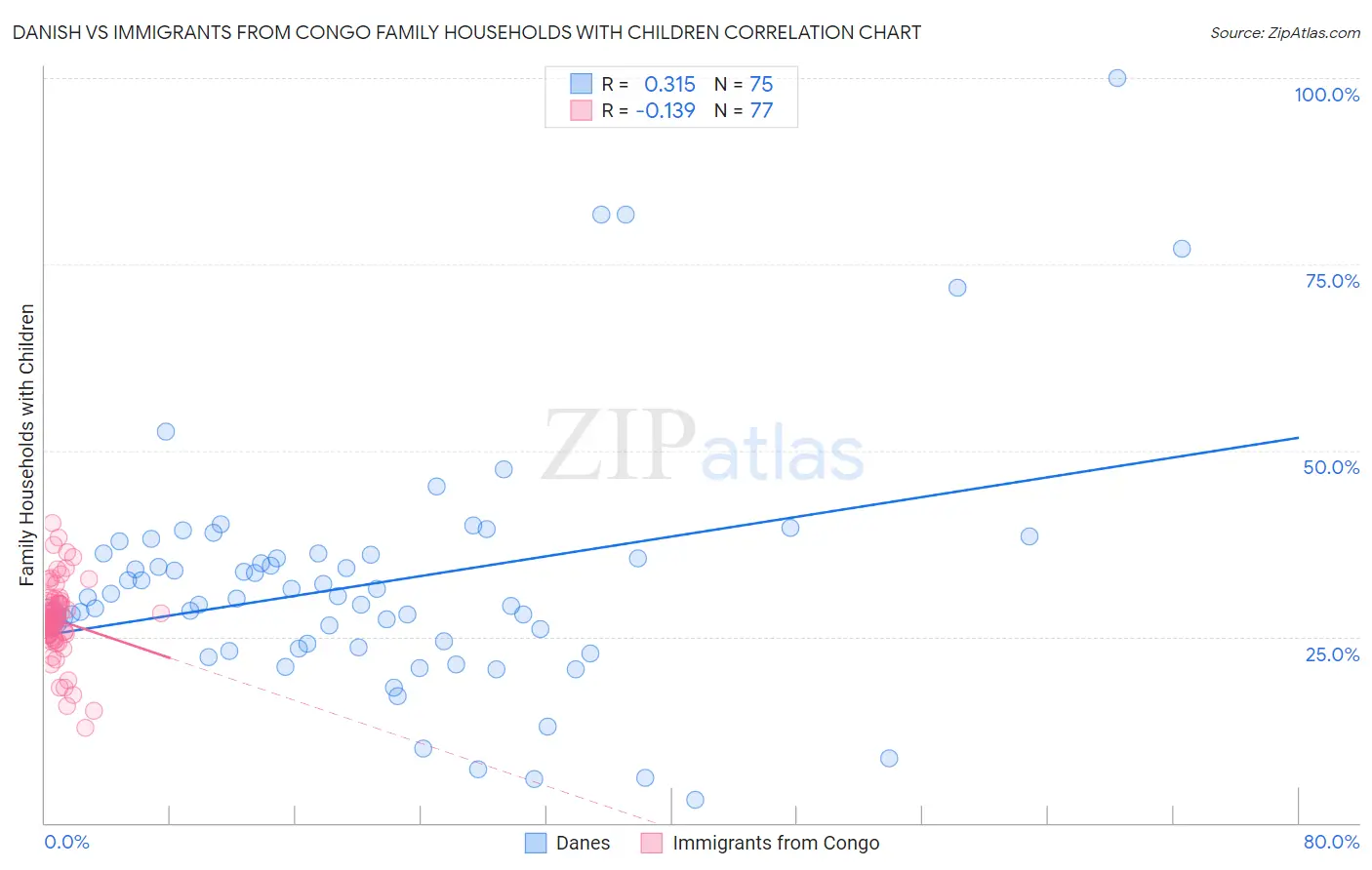Danish vs Immigrants from Congo Family Households with Children
COMPARE
Danish
Immigrants from Congo
Family Households with Children
Family Households with Children Comparison
Danes
Immigrants from Congo
28.7%
FAMILY HOUSEHOLDS WITH CHILDREN
100.0/ 100
METRIC RATING
57th/ 347
METRIC RANK
27.3%
FAMILY HOUSEHOLDS WITH CHILDREN
28.7/ 100
METRIC RATING
200th/ 347
METRIC RANK
Danish vs Immigrants from Congo Family Households with Children Correlation Chart
The statistical analysis conducted on geographies consisting of 473,642,797 people shows a mild positive correlation between the proportion of Danes and percentage of family households with children in the United States with a correlation coefficient (R) of 0.315 and weighted average of 28.7%. Similarly, the statistical analysis conducted on geographies consisting of 92,083,447 people shows a poor negative correlation between the proportion of Immigrants from Congo and percentage of family households with children in the United States with a correlation coefficient (R) of -0.139 and weighted average of 27.3%, a difference of 5.3%.

Family Households with Children Correlation Summary
| Measurement | Danish | Immigrants from Congo |
| Minimum | 3.0% | 12.8% |
| Maximum | 100.0% | 40.2% |
| Range | 97.0% | 27.4% |
| Mean | 32.3% | 27.3% |
| Median | 30.2% | 27.3% |
| Interquartile 25% (IQ1) | 23.6% | 25.2% |
| Interquartile 75% (IQ3) | 36.1% | 29.6% |
| Interquartile Range (IQR) | 12.5% | 4.4% |
| Standard Deviation (Sample) | 16.7% | 5.0% |
| Standard Deviation (Population) | 16.6% | 5.0% |
Similar Demographics by Family Households with Children
Demographics Similar to Danes by Family Households with Children
In terms of family households with children, the demographic groups most similar to Danes are Hawaiian (28.7%, a difference of 0.15%), Immigrants from Guatemala (28.8%, a difference of 0.24%), Immigrants from Asia (28.8%, a difference of 0.31%), Sierra Leonean (28.9%, a difference of 0.38%), and Immigrants from Cambodia (28.9%, a difference of 0.45%).
| Demographics | Rating | Rank | Family Households with Children |
| Immigrants | Immigrants | 100.0 /100 | #50 | Exceptional 28.9% |
| Immigrants | Peru | 100.0 /100 | #51 | Exceptional 28.9% |
| Guatemalans | 100.0 /100 | #52 | Exceptional 28.9% |
| Immigrants | Cambodia | 100.0 /100 | #53 | Exceptional 28.9% |
| Sierra Leoneans | 100.0 /100 | #54 | Exceptional 28.9% |
| Immigrants | Asia | 100.0 /100 | #55 | Exceptional 28.8% |
| Immigrants | Guatemala | 100.0 /100 | #56 | Exceptional 28.8% |
| Danes | 100.0 /100 | #57 | Exceptional 28.7% |
| Hawaiians | 100.0 /100 | #58 | Exceptional 28.7% |
| Immigrants | Nigeria | 100.0 /100 | #59 | Exceptional 28.6% |
| Hmong | 99.9 /100 | #60 | Exceptional 28.6% |
| Immigrants | Ghana | 99.9 /100 | #61 | Exceptional 28.6% |
| Egyptians | 99.9 /100 | #62 | Exceptional 28.6% |
| Immigrants | Lebanon | 99.9 /100 | #63 | Exceptional 28.6% |
| Filipinos | 99.9 /100 | #64 | Exceptional 28.6% |
Demographics Similar to Immigrants from Congo by Family Households with Children
In terms of family households with children, the demographic groups most similar to Immigrants from Congo are English (27.3%, a difference of 0.090%), Bhutanese (27.3%, a difference of 0.10%), Immigrants from Romania (27.4%, a difference of 0.15%), Cheyenne (27.4%, a difference of 0.16%), and Norwegian (27.4%, a difference of 0.16%).
| Demographics | Rating | Rank | Family Households with Children |
| Swedes | 36.9 /100 | #193 | Fair 27.4% |
| Immigrants | Iran | 36.1 /100 | #194 | Fair 27.4% |
| Crow | 35.7 /100 | #195 | Fair 27.4% |
| Cheyenne | 35.1 /100 | #196 | Fair 27.4% |
| Norwegians | 35.0 /100 | #197 | Fair 27.4% |
| Immigrants | Romania | 34.4 /100 | #198 | Fair 27.4% |
| English | 32.0 /100 | #199 | Fair 27.3% |
| Immigrants | Congo | 28.7 /100 | #200 | Fair 27.3% |
| Bhutanese | 25.1 /100 | #201 | Fair 27.3% |
| Americans | 22.8 /100 | #202 | Fair 27.3% |
| Kiowa | 22.2 /100 | #203 | Fair 27.3% |
| Immigrants | Sudan | 21.6 /100 | #204 | Fair 27.3% |
| Immigrants | Haiti | 20.3 /100 | #205 | Fair 27.2% |
| Immigrants | Micronesia | 20.2 /100 | #206 | Fair 27.2% |
| Haitians | 19.8 /100 | #207 | Poor 27.2% |